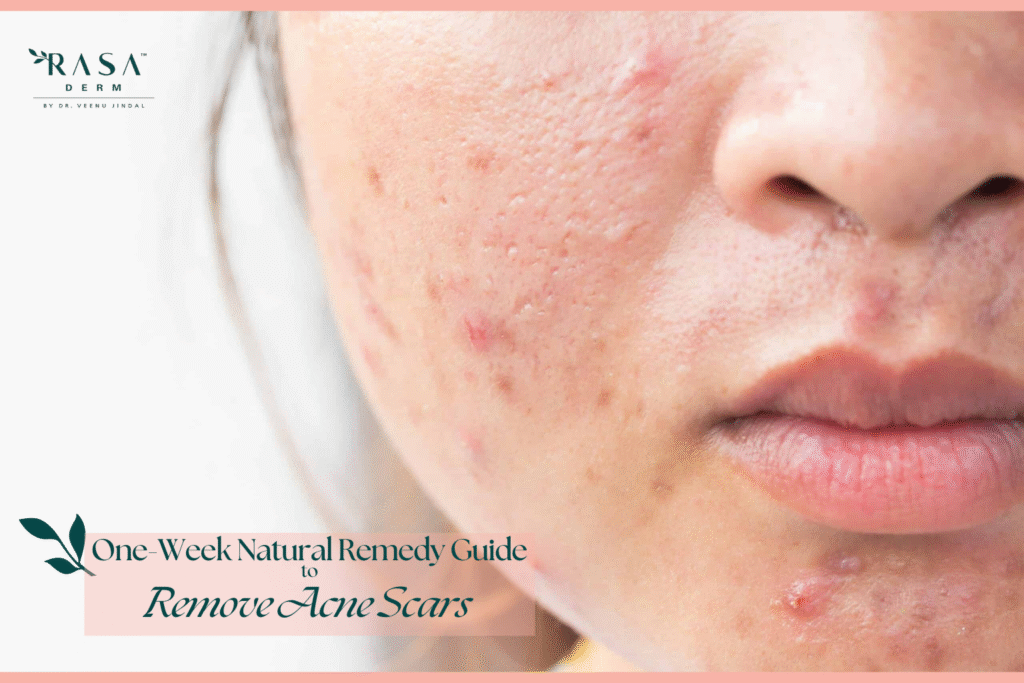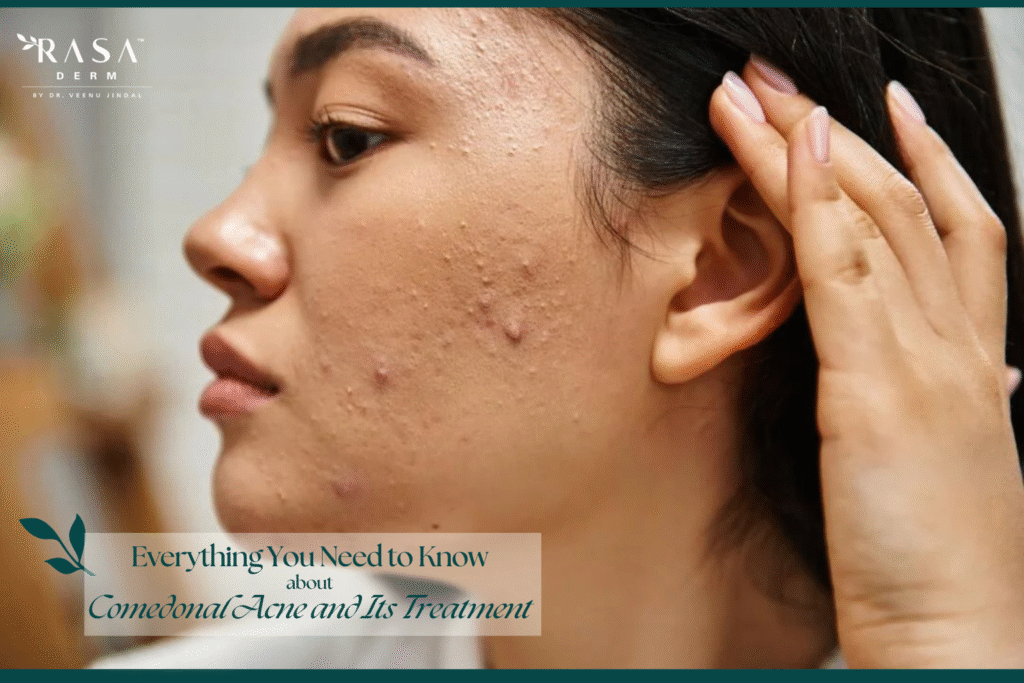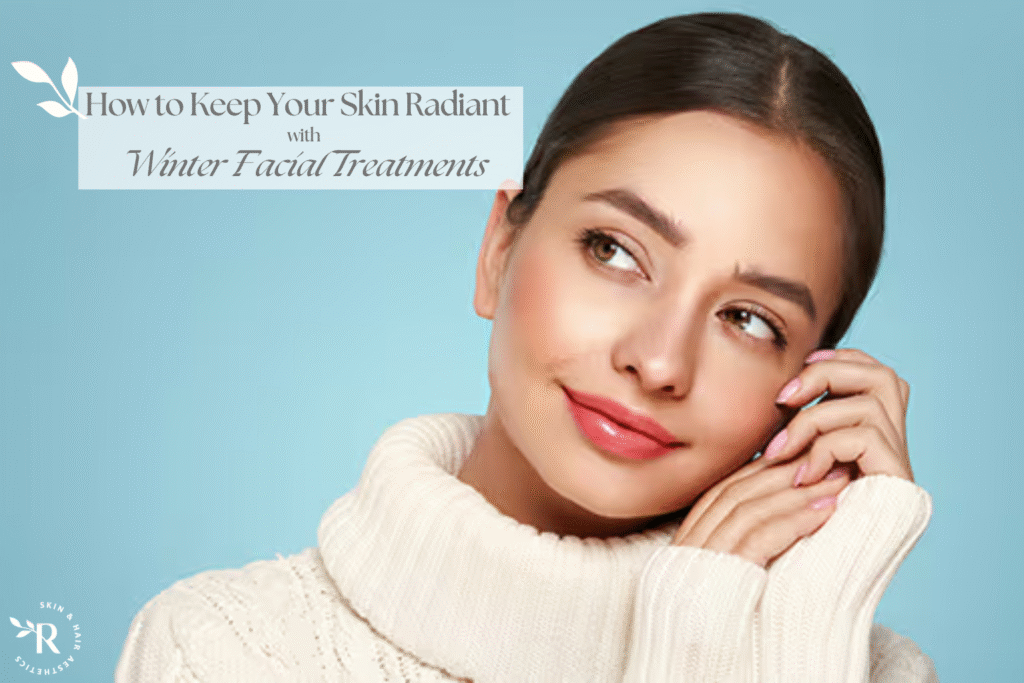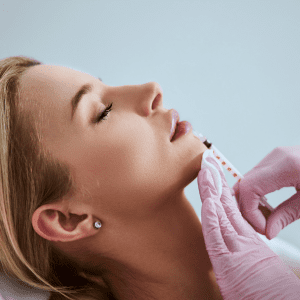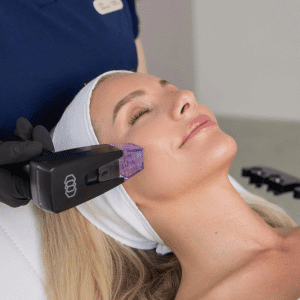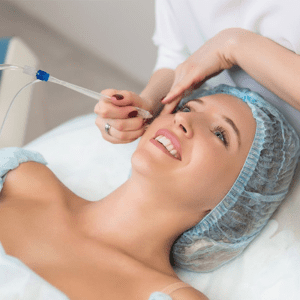In the ever-evolving world of skincare, the quest for flawless skin seems to be an unending journey. From battling acne during our teenage years to fighting off wrinkles and fine lines as we age, our skin goes through various phases and challenges. One treatment that stands as a beacon of hope in addressing a myriad of skin issues is the chemical peel treatment. At Rasa Derm Clinic, we specialize in offering transformative chemical peeling treatment in Delhi that target a wide range of skin concerns including acne, sun spots, Wrinkles, Redness, and pigmentation, helping you to unveil a rejuvenated complexion.
The Marvel of Chemical Peel Treatment
Chemical peeling are a powerhouse in the skincare industry, renowned for their ability to revitalize and transform the skin. By utilizing a specially formulated chemical solution that exfoliates the outer layer of skin, this treatment encourages the growth of new, healthy skin cells, thereby improving the texture and appearance of the skin.
Whether you are grappling with persistent acne scars that mar your complexion or sun spots that add years to your face, Skin peeling agents can be your ally in combating these issues. Moreover, it is an effective remedy for redness and other scars, offering a smoother and more even skin tone.
Advantages of Undergoing Chemical Peeling Treatment
Embark on a transformative journey to achieve radiant and youthful skin with Rasa Derm Clinic. Our chemical peel treatments are designed to offer solutions to a variety of skin issues, helping you to unveil a complexion that is free of acne, redness, and pigmentation. With improved texture and a reduction in oiliness, you can look forward to skin that radiates health and vitality.
- Acne Management: Chemical peels can significantly reduce the occurrence of acne by unclogging pores and removing dead skin cells, which are often the breeding ground for acne-causing bacteria.
- Diminishing Acne Scars: The treatment can visibly reduce acne scars by promoting the regeneration of new skin cells, which gradually replace the scarred tissue.
- Sun Spots Reduction: Chemical peels can lighten sun spots by targeting the melanin deposits in the skin, helping to even out your skin tone over time.
- Alleviating Pigmentation or Hyperpigmentation: The treatment can alleviate pigmentation or hyperpigmentation issues by exfoliating the top layer of the skin, revealing a more even complexion underneath.
- Smoothing Wrinkles and Fine Lines: Chemical peels can smooth wrinkles and fine lines by stimulating collagen production, which enhances the skin’s elasticity and firmness.
- Reducing Redness: The treatment can help reduce redness associated with various skin conditions by soothing inflammation and promoting healing.
- Minimizing Other Scars: Apart from acne scars, chemical peels can also minimize the appearance of other scars by encouraging the growth of new, healthy skin cells.
- Lightening Melasma: Chemical peels can be effective in lightening melasma by targeting the deeper layers of the skin where the pigmentation occurs, promoting an even skin tone.
- Promoting General Glow and Skin Lightening: The treatment can enhance the general glow and lightening of the skin by removing the dull, outer layer of skin cells, revealing a brighter, more radiant complexion underneath.
- Managing Rosacea: Chemical peels can assist in managing rosacea symptoms by reducing inflammation and redness associated with the condition.
- Shrinking Open Pores: The treatment can help shrink open pores by encouraging skin tightening and promoting a smoother skin texture.
- Improved Texture: Chemical peels can significantly improve the texture of your skin by encouraging the growth of new skin cells, resulting in a smoother and more youthful appearance.
- Reducing Oiliness: The treatment can help in reducing oiliness by controlling the production of sebum, which is often the cause of oily skin and acne.
- Fading Freckles: Chemical peels can fade freckles by targeting the pigmented cells in the skin, helping to create a more even skin tone.
Types of Chemical Peel
1. Mandelic Acid Peel
- Acne and Acne Scars: Helps in reducing acne breakouts by unclogging pores and lightening acne scars.
- Pigmentation or Hyperpigmentation: Effectively lightens dark spots and evens out skin tone.
- Rosacea: Its anti-inflammatory properties can soothe redness associated with rosacea.
2. Salicylic Acid Peel
- Acne: Deeply penetrates pores to dissolve excess sebum, making it highly effective in treating acne.
- Reducing Oiliness: Helps in controlling oil production, thereby reducing oiliness and shine.
- Open Pores: Minimizes the appearance of open pores by unclogging and cleansing them.
3. Lactic Acid Peel
- Wrinkles and Fine Lines: Promotes collagen production, helping to reduce the appearance of wrinkles and fine lines.
- General Glow and Skin Lightening: Gently exfoliates the skin, revealing a brighter complexion and enhancing the skin’s natural glow.
- Improved Texture: Helps in smoothing the skin texture by removing dead skin cells.
4. Glycolic Acid Peel
- Sun Spots and Freckles: Effectively lightens sun spots and freckles by promoting skin cell turnover.
- Improved Texture: Enhances skin texture by promoting collagen production and cellular regeneration.
- Melasma: Can help in reducing the appearance of melasma by exfoliating the affected skin layers.
5. Yellow Peel
- Melasma and Pigmentation: Specifically targets melasma and pigmentation, promoting an even skin tone.
- General Glow and Skin Lightening: Enhances the overall glow of the skin by revitalizing the skin layers and lightening the complexion.
- Other Scars: Helps in reducing the appearance of various scars by promoting skin regeneration.
6. Azelaic Acid Peel
- Rosacea and Redness: Effectively treats rosacea by reducing inflammation and redness.
Acne and Acne Scars: Helps in treating acne and lightening acne scars by its antibacterial properties. - Pigmentation or Hyperpigmentation: Aids in reducing pigmentation by inhibiting melanin production.
7. Kojic Acid Peel
- Sun Spots and Melasma: Lightens sun spots and melasma by inhibiting melanin production.
- General Glow and Skin Lightening: Promotes a brighter complexion by lightening the skin and enhancing its natural glow.
- Freckles: Helps in lightening freckles by targeting the melanin in the skin.
8. Biore Peel
- General Glow and Skin Lightening: Depending on the specific formulation, it can enhance the skin’s natural glow and promote skin lightening.
- Improved Texture: This can help in improving the skin texture by promoting skin cell regeneration.
- Reducing Oiliness: This may assist in controlling oil production, thereby reducing oiliness and giving a matte finish to the skin.
How Chemical peeling Treatment is Administered
Step 1: Consultation
Before the treatment, a consultation with a Chemical Peeling Expert Dermatologist in Delhi is necessary to assess your skin type, discuss your concerns, and determine the most appropriate type of chemical peel for you (light, medium, or deep peel). Dr. Veenu Jindal the Best Dermatologist for Chemical peel at Rasa Derm is here to assist you.
Step 2: Pre-Treatment Care
Depending on the type of peel chosen, you might be advised to follow a pre-treatment skincare regimen for a few weeks. This regimen may include using sunblock and certain skin-lightening products to prepare your skin for the peel.
Step 3: Cleansing the Skin
On the day of the treatment, your skin will be thoroughly cleansed to remove any oils and dirt. This ensures that the chemical solution adheres well to the skin.
Step 4: Protecting Sensitive Areas
Sensitive areas of the face, like the eyes and lips, are protected using a special ointment or gauze to prevent any irritation from the chemical solution.
Step 5: Applying the Chemical Solution
The specialist will then apply the chemical solution to your skin. The solution may contain various acids, such as glycolic acid, trichloroacetic acid, or salicylic acid, depending on the type of peel. You might feel a tingling or burning sensation during this step, which is normal.
Step 6: Monitoring the Skin
The solution is left on the skin for a specified amount of time, during which your skin is closely monitored to check the reaction and to determine when the peel should be neutralized.
Step 7: Neutralizing the Solution
After the appropriate time has passed, the chemical solution is neutralized and removed from the skin. This is usually done using a neutralizing solution or water.
Step 8: Applying Post-Peel Products
After the peel is neutralized, post-peel products like a soothing ointment or a moisturizer are applied to the skin to help with the healing process.
Step 9: Post-Treatment Care
You will be given specific post-treatment care instructions to follow at home, which might include using a gentle cleanser, applying a moisturizer, and avoiding sun exposure.
Note:
The depth of the peel (light, medium, or deep) will determine the intensity of the treatment and the recovery time. Light peels may cause slight redness and peeling, while medium to deep peels may result in more significant peeling, redness, and swelling.
It’s important to choose a qualified and experienced specialist to administer the chemical peel to ensure the safety and effectiveness of the treatment.
DO’S and DON’T’S
Dos:
- Follow Pre-Treatment Instructions: Adhere to any pre-treatment instructions provided by your specialist, which might include avoiding certain medications or skincare products.
- Sun Protection: Protect your skin from the sun before and after the treatment to prevent pigmentation issues.
- Hydrate Your Skin: Keep your skin well-hydrated before the treatment to help with the healing process.
- Inform Your Specialist: Let your specialist know about any allergies or skin sensitivities you have to avoid adverse reactions.
Don’ts:
- Avoid DIY Peels: Do not attempt to do chemical peels at home, as improper application can lead to burns and scars.
- No Scrubbing or Exfoliating: Avoid scrubbing or exfoliating your skin for at least a week before the treatment to prevent irritation.
- Avoid Waxing or Hair Removal Creams: Do not wax or use hair removal creams on the treatment area for at least a week before the procedure.
- No Picking or Peeling: After the treatment, resist the urge to pick or peel flaking skin, as this can lead to scarring.
- Avoid Harsh Skincare Products: Stay away from skincare products containing retinoids, alpha hydroxy acids, or beta hydroxy acids for a few days before and after the treatment to prevent skin irritation.
Tips For After Care
1. Avoid Sun Exposure
Sunspots, Pigmentation, and Melasma: Protect the treated areas from sun exposure to prevent the worsening of sunspots, pigmentation, or melasma.
Rosacea and Redness: Sun exposure can exacerbate rosacea and redness; use a broad-spectrum sunscreen to protect your skin.
2. Gentle Skincare
Acne and Acne Scars: Use gentle, non-comedogenic products to avoid aggravating acne or acne scars.
Open Pores and Improved Texture: Maintain the improved texture and minimized pores by using mild cleansers and moisturizers.
3. Hydration and Moisturization
Wrinkles and Fine Lines: Keep the skin hydrated to support the healing process and minimize the appearance of wrinkles and fine lines.
General Glow and Skin Lightening: Maintain a general glow and skin lightening by keeping the skin well-moisturized.
4. Avoid Scratching or Picking
Other Scars and Freckles: Avoid scratching or picking at the skin to prevent the formation of new scars or the worsening of existing freckles.
5. Oil Control
Reducing Oiliness: Use oil-free products to help control oiliness without causing dryness or irritation.
6. Follow Specific Aftercare Instructions
All Concerns: Follow any specific aftercare instructions provided by your skincare provider to address your individual concerns effectively.
7. Hydrate Internally
Overall Skin Health: Drink plenty of water to help maintain skin elasticity and promote overall skin health.
8. Avoid Harsh Products
All Concerns: Avoid using harsh skincare products, including those containing alcohol, which can irritate the skin and hinder the healing process.
9. Patience and Time
All Concerns: Allow sufficient time for the skin to heal and regenerate. The full results of the chemical peel may take several weeks to become apparent.
Frequently Asked Questions
- Is Chemical Peeling Treatment Safe?
Chemical peeling treatment is generally considered safe when performed by a qualified and experienced specialist. However, like any medical procedure, it carries certain risks and potential side effects. It is essential to have a detailed consultation with a specialist to assess your individual suitability for the treatment.
- How Many Sessions Will I Need?
The number of sessions needed will depend on the individual’s skin condition and the desired results. Some people may see significant improvements with one treatment, while others may require multiple sessions.
- Is Chemical Peeling the Best Treatment for Face Conditions?
The effectiveness of Face peeling Treatment depends on the specific condition you are referring to. Generally, it is known to be effective for treating various skin issues such as acne scars, hyperpigmentation, open pores, Melasma and fine lines. RasaDerm Clinic in offers the best chemical peel treatment in Delhi which can evaluate your skin and Texture.
- What is the Recovery Time for Chemical Peel?
The recovery time depends on the type of peel used. Superficial peels may require 1-7 days, medium peels can take up to 14 days, and deep peels might require a few weeks for full recovery.
- What is the Chemical Peeling Cost in Delhi?
The Best Chemical Peeling Treatment in delhi with Latest Prices can vary widely based on various factors such as the complexity of the treatment. Generally, the price range can be anywhere from a few thousand to several tens of thousands of Indian Rupees per session.
- What are the Risks of Chemical Peel Treatment?
Chemical peel treatment, while generally safe, does carry some risks including skin irritation, redness, peeling, and potential scarring. In some cases, there might be a change in skin pigmentation or allergic reactions to the chemicals used. It is vital to follow the post-treatment care instructions provided by your specialist to minimize these risks.



